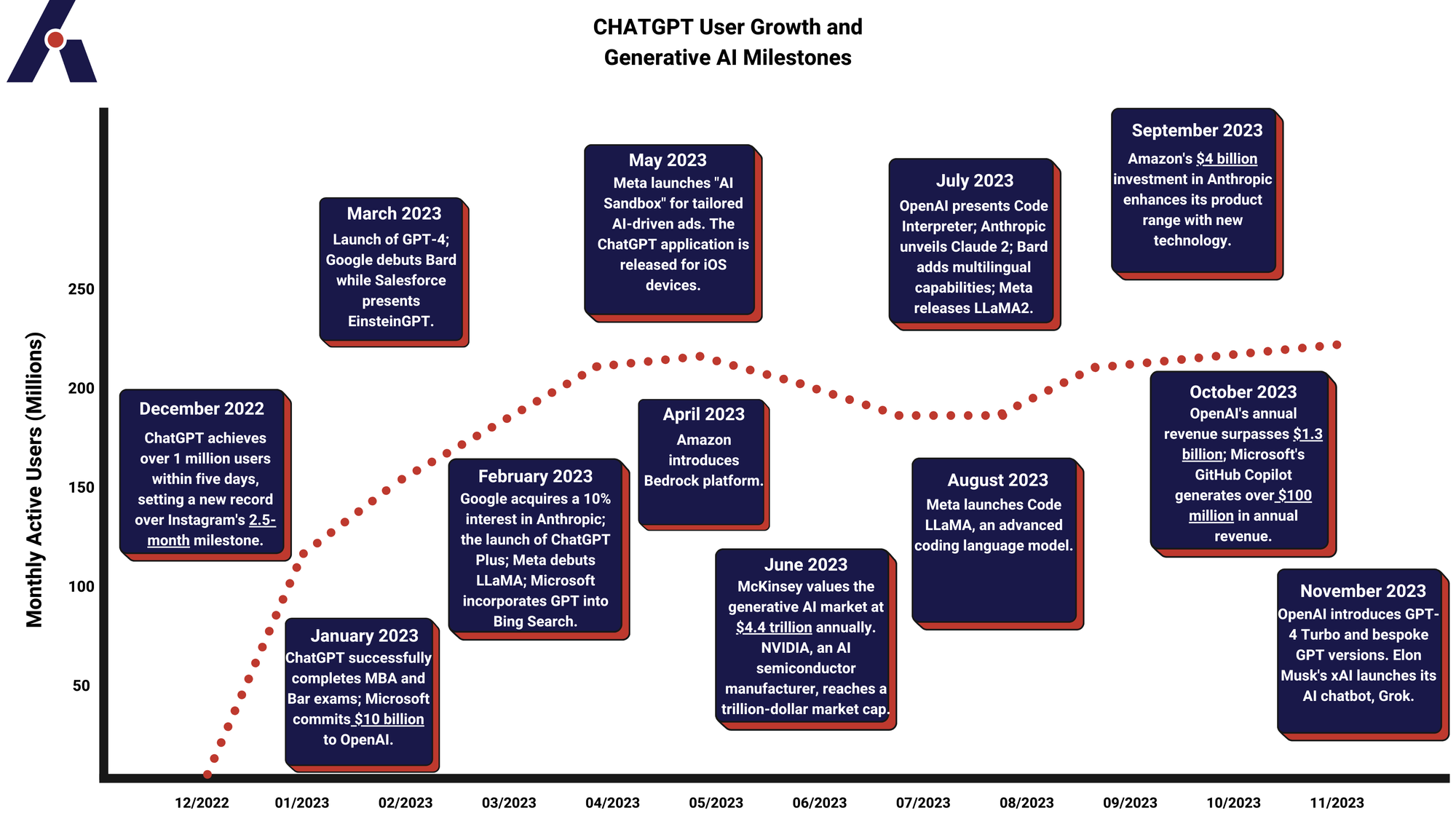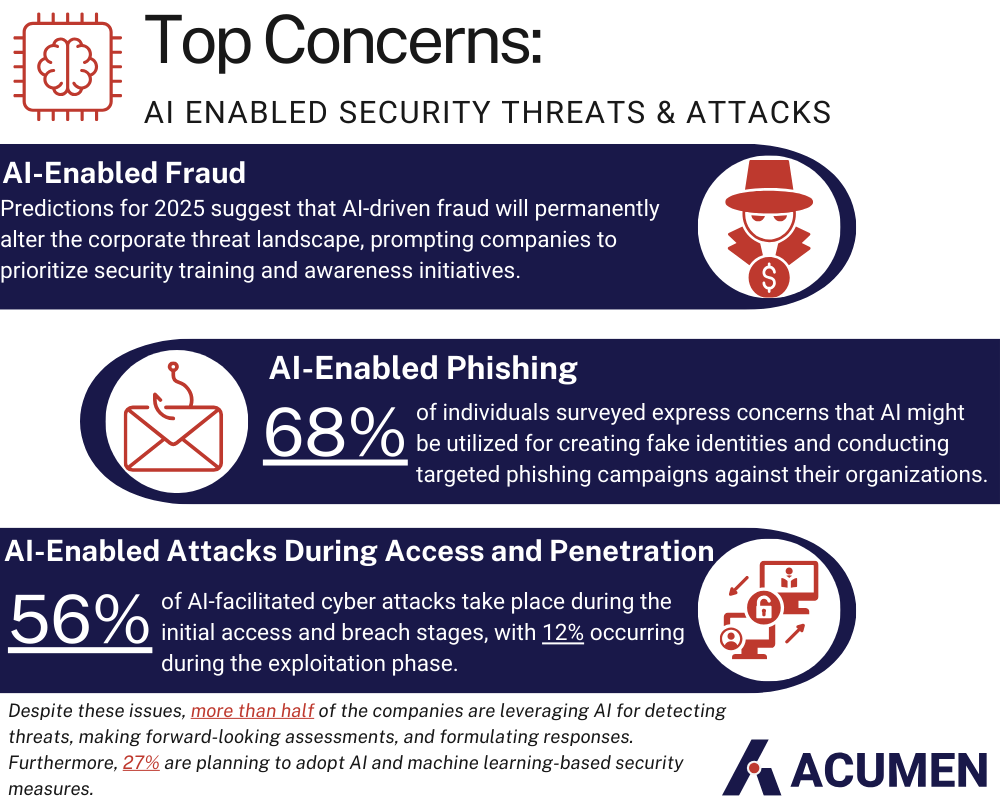AI in Cyber Security - Navigating the Evolving Threat Landscape
As AI technologies and cyber threats evolve in tandem, organizations are confronted with the challenge of strategically fortifying their defenses.

Last year's digital innovation landscape was profoundly influenced by the rapid advancement of Artificial Intelligence (AI), with platforms like ChatGPT taking center stage. These technological developments not only revolutionize user interactions but also highlight AI’s pivotal role in cyber security. As AI technologies and cyber threats evolve in tandem, organizations are confronted with the challenge of strategically fortifying their defenses. The marked increase in cyber incidents, as reported by 75% of security professionals according to Cobalt's article on top cyber security statistics for 2024, coupled with the projected global impact of cybercrime at 9.5 trillion USD, underscores the urgent need for robust cyber security measures to counter the escalating AI-driven threats.
As we address AI's implications for cyber security, it's crucial to also highlight its transformative effects across industries. A standout instance is Siemens' upcoming deployment of ChatGPT within Teamcenter, their enterprise PLM (Product Lifecycle Management) application, demonstrated at Hannover Messe, the premier global manufacturing tradeshow. Siemens showcased how ChatGPT streamlines the generation of PLC (Programmable Logic Controller) code, thereby enhancing manufacturing processes. This application of AI not only simplifies complex operations but also boosts efficiency, key for sustaining a competitive edge in today's industrial sectors. While Siemens' integration of AI demonstrates positive strides, it is essential to recognize that the same technological advances also enhance cyber security threats.

The Rise in AI-Enhanced Cyber Threats
The integration of AI into cybersecurity can enhance threat detection and response capabilities. This process improves security measures over time through learning and pattern recognition, offering faster response times to cyber threats. For example, platforms like CrowdStrike Falcon and Palo Alto Networks Cortex XDR utilize AI to analyze data and identify threatening patterns effectively, providing organizations with critical insights into security anomalies. However, this also presents a challenge, as cybercriminals gain access to sophisticated AI tools to refine their attack strategies. The substantial rise in cyber incidents throughout the past year exemplifies the urgent need for organizations to adopt proactive and enhanced cyber security practices.

The deployment of AI chatbots in professional settings, while offering numerous benefits, has revealed new exploitable security flaws. A notable incident last year involved a bug in the Redis open-source library, which is often integrated with applications like ChatGPT for data management and caching. This bug led to the unintentional exposure of personal data. Furthermore, a security lapse at Samsung underscores the risks associated with AI tools in professional settings. Samsung engineers mistakenly shared proprietary code with ChatGPT while debugging, inadvertently risking its inclusion in the chatbot’s public dataset. These incidents highlight the critical need for stringent data security measures, strict AI chatbot usage guidelines, and vigilant monitoring to prevent security breaches.
The widespread use of generative AI has introduced complex challenges in cyber security. Most notably, the novel use of AI technology to generate realistic audio and video of people is known as deepfake technology. A notable use of this technology was in an incident reported by CNN. In February 2024, a finance worker at a multinational company was deceived into transferring 25 million USD. The scam utilized deepfake technology during a video conference call, making it appear as though the company's chief financial officer and other staff members were present. In reality, all participants were deepfake recreations. The worker was initially skeptical due to a message from the supposed CFO discussing a secretive transaction. However, the convincing appearance and voices of the deepfake individuals led the worker to proceed with the transaction.
Another unsettling use of deepfake technology was highlighted by a report from the National Post in March 2022. A manipulated video purported to show Ukrainian President Volodymyr Zelenskyy capitulating to Russian demands. Although the deepfake was poorly executed, with noticeable discrepancies in skin tone and pixelation, it served as a stark reminder of the potential for such technologies to spread disinformation and cause unrest. This incident, while not convincing to viewers, points to a future where more sophisticated deepfakes could pose serious threats to global security and public trust. Altogether, these cases emphasize the advancing sophistication of AI-generated deceptions and the critical need for advanced detection methods, secure frameworks, and heightened digital literacy.

The introduction of Generative AI models like ChatGPT, Bard, and Claude AI has dramatically altered the cyber security field. These technologies equip cybercriminals with the tools to quickly create complex social engineering attacks and malicious software, leveraging AI chatbots such as FraudGPT and DarkBERT for their schemes. These harmful bots are crafted for intricate phishing operations and to find and exploit weaknesses in systems, emphasizing the rising role of harmful AI in cyber security. The simplicity with which these AI models can produce malicious content has led to a significant rise in cyber threats, with a 173% increase in phishing activities in the third quarter of 2023 alone. While Generative AI offers great promise in enhancing threat detection, automating security, and managing vulnerabilities, it also opens doors for cyber adversaries to exploit. Its core technology, based on deep neural networks that digest and learn from vast amounts of data to create new content, represents a double-edged sword. It brings both potential advantages and risks to the cyber security landscape.

The rapid adoption of AI technologies has brought significant progress but also concerns about their misuse, especially in areas like phishing and network breaches. A report from Diplomacy Education emphasizes the complex challenges of using AI tools such as ChatGPT in professional environments, where they're vulnerable to harmful use. The advanced capabilities of generative AI heighten these risks, enabling cybercriminals to create more persuasive phishing attacks and craft malware that can bypass traditional security defenses.
Preparing for AI-Powered Threats
Faced with the ever-changing threats driven by AI, organizations must adopt a comprehensive cyber security strategy that goes beyond traditional measures. This strategy should integrate technical safeguards with policy and procedural updates, embracing zero-trust principles to effectively manage the complex risks associated with AI technologies. As we advance in our digital transformation efforts, it's essential to incorporate strict cyber security protocols into everyday business processes to protect against the advanced threats posed by AI developments.
Leveraging AI Risk Management Frameworks:
Organizations can benefit from adopting structured frameworks like the NIST AI Risk Management Framework (AI RMF). This framework provides a comprehensive approach to managing AI risks across different aspects—from privacy and security breaches to ethical implications and societal impacts. By integrating the NIST AI RMF, businesses can effectively map, measure, manage, and govern AI-related risks, ensuring a proactive stance against potential cyber security vulnerabilities and other AI-related challenges.
Enhancing Cyber Security Strategies with AI:
To strengthen their defenses against AI-driven threats, organizations need to combine traditional best practices, like regular software updates, comprehensive employee training, and strict network segmentation, with modern AI-powered security tools. These innovative solutions provide predictive analytics, enhanced threat detection, and rapid response capabilities, marking a significant shift in cyber security strategy. However, the implementation of these technologies requires careful attention to potential biases, ensuring operational transparency, and maintaining a commitment to ethical standards in AI usage.
Securing Data and Maximizing AI Benefits:
In workplaces where AI chat tools are essential, safeguarding sensitive data requires stringent security protocols. This includes setting up strict access controls and encryption methods to protect data, whether stored or in transit, keeping it confidential and safe from unauthorized access. Conducting regular security audits and compliance checks is crucial for identifying vulnerabilities and ensuring alignment with standard security practices. It's also critical to educate employees about cyber security best practices, raise awareness about potential risks, and promote the secure use of AI chat tools. Additionally, implementing advanced threat detection systems that can identify and alert unusual activities plays a key role in minimizing the chances of data breaches. By adopting these comprehensive security measures, organizations can enhance their preparedness for the sophisticated challenges that lie ahead in cyber security, ensuring a robust and secure digital environment.

Conclusion
The year 2023 has highlighted the significant impact of AI on the digital world, especially in cyber security. The rapid development of AI technologies brings complex challenges, requiring a strategic approach that capitalizes on AI's advantages and addresses its weaknesses. Navigating this shifting threat environment demands a balanced strategy that emphasizes ongoing adaptation, teamwork, and innovation. This approach is crucial for protecting our digital future against the evolving challenges posed by AI advancements.
References
- BDO Digital. (2023, September 22). AI-powered cyber attacks: Understanding and mitigating the risks. BDO. [https://www.bdodigital.com/insights/cybersecurity/ai-powered-cyber-attacks-understanding-and-mitigating-the-risks]
- Chilton, J. (2023, April 21). The New Risks ChatGPT Poses to Cybersecurity. [https://hbr.org/2023/04/the-new-risks-chatgpt-poses-to-cybersecurity]
- Clark, S. (2023, December 21). The Era of AI: End of Year AI Recap. CMSWIRE. [https://www.cmswire.com/digital-experience/the-era-of-ai-end-of-year-ai-recap/]
- Cyber Management Alliance. (2023, July 17). The impact of artificial intelligence on cybersecurity. CM Alliance. [https://www.cm-alliance.com/cybersecurity-blog/the-impact-of-artificial-intelligence-on-cybersecurity]
- Data Science Dojo. (2023, August 2). AI in Cybersecurity. [https://datasciencedojo.com/blog/ai-in-cybersecurity/]
- Denny, J. (2023, December 18). 2023 AI recap: A year of innovation, adoption, and growth. People.ai. [https://www.people.ai/blog/2023-ai-recap-a-year-of-innovation-adoption-and-growth-ai-stats]
- Irei, A., & Krishnan, A. (2023, April 7). 5 ChatGPT security risks in the enterprise. TechTarget. [https://www.techtarget.com/searchsecurity/tip/ChatGPT-security-risks-in-the-enterprise]
- Malwarebytes. (n.d.). Risks of AI in cybersecurity. Malwarebytes. [https://www.malwarebytes.com/cybersecurity/basics/risks-of-ai-in-cyber-security]
- Nagar, M. (2023, July 24). ChatGPT security risks: What you need to know. Redscan. [https://www.redscan.com/news/chatgpt-security-risks/]
- Okeke, F. N. (2023). An assessment of the use of generative AI in cybersecurity: Challenges and opportunities. Faculty of Science and Technology, Department of Computing & Informatics, Bournemouth University, Bournemouth, United Kingdom.
- Ortiz, S. (2023, May 17). 6 harmful ways ChatGPT can be used by bad actors, according to a new study. ZD Net. [https://www.zdnet.com/article/6-major-risks-of-using-chatgpt-according-to-a-new-study/]
- Poremba, S. (2023, May 2). ChatGPT confirms data breach, raising security concerns. Security Intelligence. [https://securityintelligence.com/articles/chatgpt-confirms-data-breach/]
- Pratt, M. (2023, September 7). Emerging cyber threats in 2023 from AI to quantum to data poisoning. [https://www.csoonline.com/article/651125/emerging-cyber-threats-in-2023-from-ai-to-quantum-to-data-poisoning.html]
- Schneck, D. J. (2023, April 5). The Impact of AI on Pattern Recognition & Cybersecurity. [https://danschneck.com/tech/the-impact-of-ai-on-pattern-recognition-cybersecurity/]
- SecureOps. (n.d.). The use of artificial intelligence in cyber attacks and cyber defense. SecureOps. [https://secureops.com/blog/ai-offense-defense/]
- Terranova Security. (n.d.). AI in cyber security: Pros and cons. Terranova Security. [https://terranovasecurity.com/blog/ai-in-cyber-security/]
- Toulas, B. (2023, August 1). Cybercriminals train AI chatbots for phishing, malware attacks. BeepingComputer. [https://www.bleepingcomputer.com/news/security/cybercriminals-train-ai-chatbots-for-phishing-malware-attacks/]






